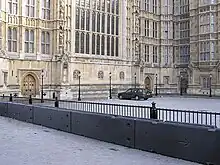Target hardening
Target hardening, also referred to simply as hardening when made clear by the context, is a term used by police officers, those working in security, and the military referring to the strengthening of the security of a building or installation in order to protect it in the event of attack or reduce the risk of theft.[1][2] It is believed that a "strong, visible defense will deter or delay an attack".[3]

In terms of business and home security, target hardening[4] is one of the suite of protective measures that are included in crime prevention through environmental design.[5] This can include ensuring all doors and windows are sourced and fitted in such a way that they can resist forcible and surreptitious intruder attack, adding hard barriers and landscapes that resist vehicle and pedestrian intrusion, adding fences, walls and hostile planting.[6] All of these are greatly assisted by removing or pruning any trees or bushes that could offer suitable hiding places or could be used to climb to a higher level of the property.[2] However, for a business, taking target hardening too far can send the wrong message out to potential customers.[7]
In military or counter-terrorism terms, target hardening refers to ensuring strategic or tactical assets are secured against adversary attack.[8]
Other more specific terms associated with target hardening include hostile vehicle mitigation[9] and "blast hardening".[10]
See also
- Armour#Other types
- Counter-terrorism
- Radiation hardening
- Aviation Security in Airport Development - A UK Department of Transport airport anti-terror target-hardening program.
References
- "Target Hardening". Business Crime Direct. Archived from the original on 2007-12-16. Retrieved 2007-11-30.
- "Target Hardening". Vancouver Police Department. Archived from the original on August 31, 2006. Retrieved 2007-11-30.
- Tom O'Connor. "Approaches to Target Hardening". Austin Peay State University. Archived from the original on 2007-07-12. Retrieved 2007-11-30.
- "Operation GIBWATCH" (PDF). Royal Gibraltar Police. Retrieved 3 July 2017.
- Cozens, P.; Love, T. (6 August 2015). "A Review and Current Status of Crime Prevention through Environmental Design (CPTED)". Journal of Planning Literature. 30 (4): 4. doi:10.1177/0885412215595440. S2CID 55959202. Retrieved 3 July 2017.
- "Defensive plants, shrubs and trees (shrub fences) | The Crime Prevention Website". thecrimepreventionwebsite.com. Retrieved 3 July 2017.
- Joseph Murrary. "Target Hardening". Blue Ridge Community College. Archived from the original on 2008-09-14. Retrieved 2007-11-30.
- Tom O'Connor. "Incident Management of Domestic Terrorism". Austin Peay State University. Archived from the original on 2007-07-13. Retrieved 2007-11-30.
- "Hostile vehicle mitigation | Public Website". www.cpni.gov.uk. Retrieved 3 July 2017.
- Designing Blast Hardened Structures for Military and Civilian Use (abstract)
Further reading
- Target Hardening at a New York City Subway
- Target Hardening the City of Orlando
- The Target Hardening Trap